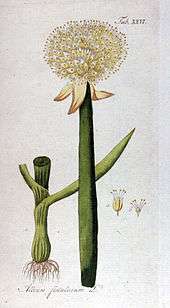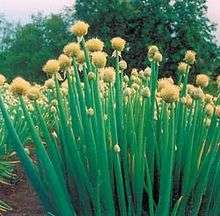Allium fistulosum
 Allium fistulosum
| ||||||||||||||||||||||||||||||||||||||||||||||||||||||||||||||||||||||||||||||||||||||||||||||||||||||
Allium fistulosum L. (Welsh onion, Japanese bunching onion, bunching onion) is a species of perennial onion. The common name Welsh onion is rather a misnomer, as the species is native to China, though cultivated in many places and naturalized in scattered locations in Eurasia and North America.[1]
The species is very similar in taste and odor to the related common onion, Allium cepa, and hybrids between the two (tree onions) exist. The Welsh onion, however, does not develop bulbs, and possesses hollow leaves (fistulosum means "hollow") and scapes. Large varieties of the Welsh onion resemble the leek, such as the Japanese negi, whilst smaller varieties resemble chives. Many Welsh onions can multiply by forming perennial evergreen clumps.[2][3] Next to culinary use, it is also grown in a bunch as an ornamental plant.
Historically, the Welsh onion was known as the cibol.[4] In Cornwall, they are known as chibbles.
A. fistulosum is not indigenous to Wales or particularly common in Welsh cuisine (the green Allium common to Wales is the leek, A. ampeloprasum, the national vegetable of Wales). "Welsh" preserves the original meaning of the Old English word welisc, or Old German welsche, meaning "foreign" (compare wal- in "walnut", of the same etymological origin).
Ambiguous names
Other names that may be applied to this plant include green onion, salad onion, and spring onion. These names are ambiguous, as they may also be used to refer to any young green onion stalk, whether grown from Welsh onions, common onions, or other similar members of the genus Allium (also see scallion).
Culinary use
In the West, the Welsh onion is primarily used as a scallion or salad onion, but is widely used in other parts of the world, particularly East Asia.[5]
Russia
Welsh onions are used in Russia in the spring for adding green leaves to salads.
Asia
The Welsh onion is an ingredient in Asian cuisine, especially in East and Southeast Asia. It is particularly important in China, Japan, and Korea, hence the other English name for this plant, Japanese bunching onion. The Japanese name is negi (ネギ). Common onions were introduced to East Asia in the 19th century, but A. fistulosum remains more popular and widespread.[5]
It is used in miso soup, negimaki (beef and scallion rolls),[6] among others, and it is widely sliced up and used as a garnish, such as on teriyaki or takoyaki.
Jamaica
Known as escallion,[7] the Welsh onion is an ingredient in Jamaican cuisine, in combination with thyme, scotch bonnet pepper, garlic, and allspice (called pimenta). Recipes with escallion sometimes suggest leek as a substitute in salads. Jamaican dried spice mixtures using escallion are available commercially.
The Jamaican name is probably a variant of scallion, the term used loosely for the spring onion and various other plants in the genus Allium.
Image gallery
-

Welsh onion grown in Guizhou, China
-

Welsh onion grown in Odawara, Japan
-

A. fistulosum – MHNT
See also
References
- 1 2 "World Checklist of Selected Plant Families: Royal Botanic Gardens, Kew". kew.org.
- ↑ "Floridata Profile". floridata.com.
- ↑ Thompson, Sylvia (1995). The Kitchen Garden. Bantam Books.
- ↑ Ward, A: The Encyclopedia of Food and Beverage, New York, 1911. Retrieved January 5, 2007.
- 1 2 Fritsch, R.M.; N. Friesen (2002). "Chapter 1: Evolution, Domestication, and Taxonomy". In H.D. Rabinowitch and L. Currah. Allium Crop Science: Recent Advances. Wallingford, UK: CABI Publishing. p. 18. ISBN 0-85199-510-1.
- ↑ "Recipe – Chicken Negimaki – NYTimes.com". The New York Times. August 13, 2010. Retrieved September 15, 2012.
- ↑ "MAJOR PESTS OF ESCALLION (ALLIUM FISTULOSUM) IN JAMAICA" (PDF). Ministry of Agriculture and Lands, Jamaica. November 2006.
External links
 Media related to Welsh onion at Wikimedia Commons
Media related to Welsh onion at Wikimedia Commons Data related to Allium fistulosum at Wikispecies
Data related to Allium fistulosum at Wikispecies- PROTAbase on Allium fistulosum
- WORLD'S LARGEST Welsh onion
|

.jpg)